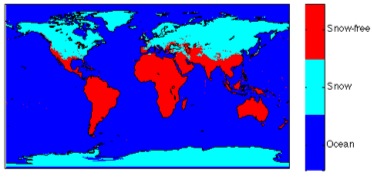| Daily Snow Cover from Microwave 1993-2004 |
|
Passive microwave has advantages over other satellite measurements for snow detection because it provides results day and night and under most weather conditions. The effective emissivity product used in this analysis has the advantage of having the contributions of the atmosphere, including clouds, removed and the physical temperature variations separated from the effective emissivity variations [Aires, 2001]. The remaining variability in the emissivities is due to changes of the land surface characteristics (soil moisture, vegetation density, surface wetness) as well as the snow properties. To investigate removal of the other non-snow surface effects from the signal, we examined the space-time variability of land emissivities for different vegetation categories with and without the presence of snow. The effect of land is removed from the signal (approximately) by subtracting the mean snow-free emissivity of each location from its emissivity with snow present. The operational NOAA snowcover charts, providing weekly snowcover from satellite visible image analysis, are used for the snow/snow free separation in this part of the analysis. When all the contributions to the signal except snow have been removed, the remaining variability of the snow signal is examined over time for each location. Infrared skin temperatures [Prigent et al., 2003a; b] and the reference snow cover data are used to find a threshold that distinguishes between snow/snow free land from the microwave emissivities. These snow products are available in daily resolutions from 1993 to 2004. A sample map of the snowcover products is shown below.  Microwave Snowcover Map Microwave Snowcover MapTo access the dataset, download Microwave Daily Snow Cover. Each file is one global square map for one day for 12 years. For the documentation and a sample of matlab and fortran code to read the data click Here. References
|